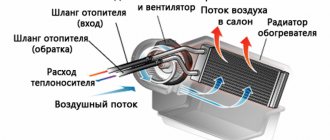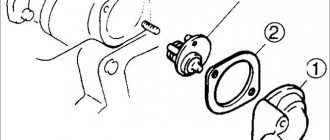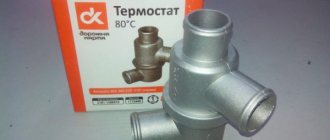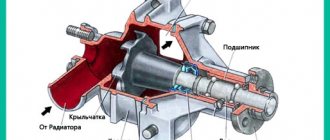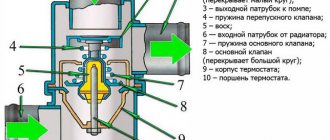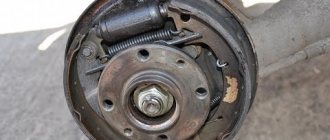Design and principle of operation
As a rule, the radiator cap is located either on the radiator itself or on the coolant expansion tank.
Hence, it should be called correctly - like a cooling system cover, and if the name also includes a functional meaning - then, according to technical terminology, it will sound correctly - like a bypass valve for the cooling system of an internal combustion engine of a car. Depending on the manufacturer and brand of car, the design of the radiator cap may differ both in appearance and in the complexity of the technical mechanism, but in any case it will consist of the following main parts:
- a tin cover with rotary clamp elements on the neck of the radiator or expansion tank;
- sealing rubber under the lid;
- intake valve mechanism;
- exhaust valve mechanism;
- two valve membranes in the form of rubberized plates;
- cover housings where the valve mechanisms are located.
The functional purpose of the radiator cap is to regulate the coolant pressure in the internal combustion engine cooling system. Therefore, the bypass valve system is designed for operation in a temperature range from a low point of -40⁰ C to a high point of +125⁰ C. The lower point is determined by the minimum winter ambient temperature, and the upper point is determined by the boiling limit of the coolant at an excess pressure of 100 kPa. That is: -40⁰ C is the freezing point of antifreeze and antifreeze, and +125⁰ C is their boiling point at slight excess pressure. For water, these temperature ranges will respectively range from 0⁰ C to +105⁰ C.
The bypass valves of the cooling system cover operate approximately according to the following three-position scheme:
- At +20⁰ C (conventionally), the pressure of the ambient air and liquid in the cooling system are equal, while both valves are closed.
- The car engine is running and heating up, causing the coolant to expand. When a certain limit is reached, the release valve opens and releases excess pressure without allowing the liquid to boil.
- After the engine is turned off, it begins to cool along with the cooling system fluid, which, in turn, decreases in volume and creates a vacuum. This is where the inlet valve opens to maintain normal pressure.
DIY repair
Restoring the functionality of this valve element consists of three stages: disassembly, cleaning, and replacement of damaged elements.
Even a beginner can repair this part of the expansion tank with his own hands, being careful and careful. To do this, you only need a screwdriver with a thin flat end.
Work must be carried out in the following sequence:
- Unscrew this part, carefully wipe its inner surface, getting rid of drops of antifreeze;
- use a screwdriver to remove the rubber seal; remove the spring that is located under the rubber;
- then remove the valve elements that have become accessible;
- using cotton swabs and soap solution, rinse the inner cavity of the lid;
- in case of visible damage or deformation, replace the spring or rubber seal;
- install all parts sequentially in reverse order.
Expensive or cheap antifreeze - is it worth paying more?
Thus, regular monitoring of the condition of the expansion tank throughout the operation of the car is an important task to ensure optimal engine operating conditions. Every car enthusiast can diagnose, prevent and repair the valve cover.
1 comment
Igorek says: Thank you, really useful article.
The design of a modern radiator
How does a radiator sealant work: is it useful, which one is better to choose?
An internal combustion engine cooling radiator, as a rule, has two tanks (lower and upper), a core in which the liquid (antifreeze or antifreeze) is cooled, and several additional parts for fastening. The liquid from the engine cooling jacket enters the radiator, where its temperature drops to the required value, then the antifreeze is again transferred to the engine. Light metals are used to make the core and tanks: either aluminum or brass. Thanks to their high thermal conductivity, they provide efficient and fast cooling of antifreeze.
The core of the radiator consists of horizontally arranged metal plates connected to hollow tubes running vertically down from the upper reservoir to the lower reservoir. Thus, when moving through the core, the liquid is divided into several streams, and the area of its contact with atmospheric air increases, leading to an increase in the cooling intensity.
Radiator pipes allow the tanks to be connected to the engine cooling jacket. The bottom tank usually has a drain tap through which liquid can be drained. The engine jacket is also equipped with a similar tap. Antifreeze is poured into the cooling system through the neck of the upper reservoir.
https://youtube.com/watch?v=fJ9OtFZQCxE
https://youtube.com/watch?v=fJ9OtFZQCxE
The functioning of cooling systems of modern cars takes into account the temperature value:
- engine;
- coolant;
- environment;
- oils, etc.
The operation of the cooling system can be explained as follows. The liquid heated by the engine is directed by a pump through pipes to the radiator, where its temperature is reduced. After which the cooled liquid (antifreeze) is again supplied to the engine jacket, and then the cycle is repeated.
Car radiator cores can be:
- tubular-lamellar;
- tubular-ribbon.
In the first case, the cooling tubes may have the following arrangement:
- chess;
- at an angle;
- in a row.
The fins of tubular-plate radiators are either flat or wavy, and can have different sizes. In addition, to enhance heat transfer, special turbulators are sometimes made on them (perforations that are bent and form narrow passages for air).
For radiators, called tubular-band radiators, the cooling tubes are always arranged in a row, and a copper sheet with a thickness of 0.05 millimeters to 0.1 millimeters is used to make the strip of their grilles. To enhance heat transfer with the help of swirls, shaped holes are made on the tape using the stamping method or bent cuts are created.
Today, the most widespread are car cooling radiators made on the basis of aluminum alloys. Such devices are cheaper and lighter than brass analogs, but are inferior to the latter in reliability and service life. Another advantage of brass radiators is that they are easier to repair: they can be soldered. While the radiator of the cooling system, known as aluminum, is more difficult to repair, since its parts and structural elements are connected to each other using rolling and sealing materials.
Selection and installation of plug
Low beam lamps VAZ-2110: types, selection, replacement
The radiator cap is one of the simplest elements that are used when installing heating radiators. However, lack of attention at this stage can lead to big problems in the future.
Selection and principle of operation of the device
There should not be any particular difficulties at this stage, because all radiator plugs are of the same type, and the main differences are in size, type of thread, etc. And the principle of operation of the radiator cap is the same.
When choosing, you need to consider:
- combination of materials (radiator metal + metal of the element itself). When purchasing a kit along with a battery, there is guaranteed to be no error. For example, a cast iron radiator plug is not the best option for copper pipes;
- type of thread, it all depends on which side of the battery it will be installed on. If on the left, then a left-hand thread is needed, on the right side - a right-hand thread;
- type, continuous or blind, which is used simply to block the hole in the end of the battery;
Pictured is a walk-through model
the aesthetic side of the issue also plays an important role; Attention should also be paid to the thread diameter of the inlet and outlet pipes. In this case, plugs for heating radiators play the role of adapters; diameters from 1/2 to 1.0 inches are common. The kit for installing the battery may include 4 through plugs (they can be found under the name futorka, that is, they play the role of an adapter with one diameter on the other), 2 brackets for hanging the battery on the wall and plastic anchors that are needed to install the brackets
The kit also includes 2 plugs or 1 plug + Mayevsky tap, you can also install it yourself
The kit for installing the battery may include 4 through plugs (they can be called plugs, that is, they act as an adapter from one diameter to another), 2 brackets for hanging the battery on the wall and plastic anchors that are needed to install the brackets. The kit also includes 2 plugs or 1 plug + Mayevsky tap; you can also install it yourself.
This kit includes everything you need
As for the principle of operation, they can perform only 2 functions:
- block the path of the coolant; to do this, simply screw a plug into the liner or into the hole in the radiator section;
- work as an adapter from one diameter to another. For ease of connection with the radiator and heating pipes, the fittings are provided with threads on both sides, external on one side and internal on the other.
Models with different threads
Installing a heating battery
Installation into the heating device is carried out last; first you need to securely fix it to the wall.
The instructions for performing the work look like this:
- First, the required number of heating radiator sections is assembled. Since a threaded connection of individual sections is used, for greater tightness of the joint you can use either oiled tow or FUM tape;
- then a place is selected under the window to place the radiator, maintaining the recommended distances to the window sill and walls. Holes are made in the wall for the brackets, then plastic inserts are driven into them and metal holders are inserted into them;
Battery Placement Guidelines
It is better to use a plastic tool
- In this case, you must not overtighten the connection, otherwise the threads or even the housing may be damaged. A microcrack may be invisible at the installation stage, but under the influence of pressure, hot water will leak through it, and repairing heating in winter is not a pleasant task;
- After installing the plugs, inlet/outlet pipelines are connected to them, a Mayevsky valve is installed in the upper part and a plug in the lower part. You can proceed to checking the tightness of the joints, for which it is enough to fill the system with water and observe whether water is leaking anywhere.
Footers location
Among the general recommendations, it can be noted that:
- The plug for a cast iron radiator requires special care. Cast iron works great in compression, but this metal is brittle, so a relatively weak blow can cause a microcrack to appear in the body. It is undesirable to even drop it on a hard surface; steel is more reliable in this regard;
- You can find recommendations when assembling the radiator itself, as well as installing plugs, to use ordinary paint for greater tightness. This will indeed provide a reliable seal of the joint, but it will not look very nice, and besides, it will be very difficult to disassemble such a connection in the future; modern heating radiators and plugs do not require painting.
https://youtube.com/watch?v=nnQz2VA7C_M
Checking the lid using improvised means
How to check the expansion tank cap. device and principle of operation of the expansion tank
Checking the operation of the bypass valve is quite simple. To do this, you need to disconnect any small pipe of the cooling system on the engine, for example, a heated damper or manifold. Next, you need to use a compressor with a pressure gauge (to know the exact pressure supplied) to supply air to the system.
The pressure value at which the valve operates will be easy to determine by hissing and gurgling coming from the elements of the cooling system
Please note that the pressure should not be released suddenly at the end of the procedure. This threatens that when opening the lid, antifreeze may splash out under pressure.
From the expansion tank, liquid enters the radiator through a check valve. It holds pressure from the radiator side, but opens quietly if there is a complete vacuum there. Its verification is carried out in two stages:
- You should try to lift the valve patch with your finger. Ideally, it should move with minimal effort (without mechanical resistance).
- On a cold engine, when there is no excess pressure in the radiator, it is necessary to install the plug in its seat. Next, disconnect the tube going to the expansion tank of the cooling system and try to “inflate” the radiator through it. The valve is rated for low pressure, so you will probably be able to blow a small amount of excess air into the radiator. This can be checked by unscrewing the radiator cap again. In this case, a characteristic hissing sound of air emanating from it should be heard. Instead of a mouth, you can also use a compressor with a pressure gauge. However, you need to make sure that the pressure does not increase sharply.
Basic malfunctions of the engine cooling system
How to replace the Lada Kalina cooling radiator
The cooling system of a car engine consists of a large number of individual parts - radiator, fan, pipe system, sensors. If at least one element does not work correctly, the entire system begins to work worse. Therefore, the cause of the breakdown may be:
- Radiator clogged. It is this element that is intended for the forced removal of thermal energy from the engine. If it becomes clogged externally (a large amount of dust and dirt gets into its slots) or internally (the core becomes clogged with a significant amount of rust and liquid sediment), then the efficiency of the unit is sharply reduced. Accordingly, the radiator, like the entire cooling system, must be periodically cleaned both outside and inside using special cleaners or improvised means.
- Faulty pump. For this reason, the cooling system either leaks from under the cooling pump bearing, or the circulation of liquid through the cooling jacket is disrupted. There are several reasons for pump failure. Among them are banal wear of its blades or internal parts, weakening of the drive, and violation of tightness. Often, corrosion can be observed on metal impellers, but the plastic impeller simply breaks off and turns.
- The thermostat is not working correctly. The main task of this unit is to block the flow of antifreeze or antifreeze into the radiator until the engine has warmed up sufficiently. On most cars, it opens only when the coolant temperature reaches +87... +95°C. Accordingly, if it fails, the engine will heat up for a very long time, especially in cold weather. If the thermostat is stuck and does not open at all, then the temperature in the system will be higher than normal until it boils. When it is open constantly, the temperature is below normal.
- Cooling fan malfunction. Depending on the type of its drive, there may be many reasons. For example, a mechanically driven fan may have loose drive tension. If the drive is electric, then the cause of its failure may be a faulty thermal relay or drive motor. If the drive is hydraulic, then the reason most likely lies in insufficient pressure (low level) of oil in the system.
- Depressurization of the system. Coolant leaks can occur in a variety of places. For example, on the pipes, their connections (on clamps), in the radiator housing, on the pump, on the cooling jacket of the cylinder head. If the cylinder head gasket burns out, the coolant mixes with the engine oil. This not only leads to a decrease in antifreeze levels, but also to a deterioration in oil performance, which puts additional stress on the engine.
- Temperature sensor malfunction. Information from it is sent to the electronic control unit, and based on it, the ECU issues commands to form an optimal air-fuel mixture, turn on/off the cooling system fan and other commands. You can check the temperature sensor using a multimeter.
- Low coolant level. Even if the cooling system is completely sealed and there are no leaks, the level of antifreeze in it still drops over time. This happens due to its evaporation. This process is quite long, but the car owner needs to periodically monitor the appropriate level and, if necessary, add or completely change the coolant if the end of its service life has come.
- Radiator cap valve leaking. In this case, the pressure in the cooling system will be below normal. Because of this, the liquid will boil even when the engine is idling. Coolant is also discharged into the expansion tank, but only after the engine is stopped. There will also be a large consumption of antifreeze.
Another malfunction can be considered the use of antifreeze with inappropriate parameters, for example, ordinary water. As you know, in cold weather it crystallizes, which usually leads to mechanical failure of the elements of the cooling system. Therefore, you need to choose antifreeze in accordance with the requirements of the car manufacturer.
Thermostat: purpose, signs of malfunction, replacement
Thermostat is a device for regulating the temperature of the coolant in the system, the main functional purpose of which is to block the flow of antifreeze while the engine is warming up. The principle of operation of the device is quite simple: the bypass and large valves, depending on the temperature, close the small and large coolant circulation circuits, respectively. The central element of the device is refractory wax, which, expanding when heated and contracting when cooled, changes the position of the piston that regulates the operation of the bypass valve.
The most common cause of malfunction or failure of the thermostat is a jammed valve. The easiest way to determine a broken thermostat
, - to the touch.
The testing process is quite simple: you need to start the engine and periodically feel the pipe coming from the bottom of the radiator. If the engine temperature has not reached 80°, and the pipe has already begun to heat up, then you will have to buy a thermostat
and replace it.
Depending on the design features of the cooling system, thermostats with different opening temperatures of the large valve are installed on cars, so you need to know exactly this parameter for your car (usually indicated on the body itself).
Does your car need constant attention? It is not surprising, because a car from which you expect long-term operation and faithful service should be systematically checked for any, even the slightest, problems, eliminating them in a timely manner and solving problems. When we mention the reliability, trouble-free operation and power of a car, we cannot help but talk about its heart - the power unit.
A car engine is constantly subject to various loads. Changes in temperature conditions also do not go unnoticed. Prolonged exposure to various climatic conditions usually causes the radiator tank to leak and cause engine failure in your car.
To prevent frequent engine replacements from placing a heavy burden on you, you should constantly monitor the temperature conditions of the antifreeze and, as a result, the engine itself. The car's cooling system is responsible for this. Modern vehicles are equipped with an intelligent cooling system that allows not only to regulate the temperature of the power unit, but also to protect the radiator metal from corrosion through lubricants. It also ensures a constant circular flow of antifreeze, thanks to its antifreeze properties.
A very important step is to select a suitable high-quality cooling element for your “pet”, because this will directly affect the service life of some of the main elements that are included in it. If at least one of the parts fails, this entails serial “killings” of other elements. The first ones most likely to be affected are the engine radiator, thermostat, expansion tank, pump, fan and radiator cap.
First of all, let's turn to the power unit cooling radiator
We think it would be unnecessary to talk at length about the importance of this detail. Its operation is carried out due to a special fan and counter air flow. This system is quite complex, but often the reason for the malfunction of the entire radiator lies only in the fact that the radiator cap has any defects or malfunctions
At first glance, it seems like a trivial element, but in fact it is very important! The cap keeps high-pressure antifreeze inside the radiator that cools the engine.
Experts strongly recommend not to save money and if you replace the radiator, be sure to purchase a new cap. In addition, its cost is relatively low. This will increase your confidence in the condition of the cooling system. Otherwise, after the power unit cooling radiator, you will have to replace another element.
Valve operation
Maintaining the pressure at the level of 1.1 - 1.5 kg/cm2 is ensured by the safety valve of the lid, which opens when the limit value is exceeded.
In addition, after the engine cools down and the coolant begins to decrease in volume, the atmospheric valve opens to allow air in, in order to avoid excessive vacuum in the system.
In order to fully appreciate the role of the expansion tank cap, it is necessary to become more familiar with how excess or insufficient pressure affects the condition of not only the cooling system, but also the engine as a whole.
What are the dangers of excess or lack of pressure?
Excessive impact from the inside on parts of the cooling system can, at a minimum, lead to the pipes being torn off the fittings. But there may be worse consequences - rupture of the thermostat housing or expansion tank. There have also been cases of depressurization of engine cooling radiators or heaters, as well as vapor breakthrough through the cylinder head gasket.
The harmful effects of low pressure are not so obvious. But it is precisely this that leads to the boiling of antifreeze.
And boiling not only disrupts heat transfer from parts, but also causes cavitation erosion, that is, tearing out metal particles from the surface. The surface of the parts becomes pitted, as it were, which over time causes their destruction.
Such expensive engine parts as the cylinder block and head fall into the “risk zone”.
If the atmospheric valve does not open when cooling the antifreeze, then a vacuum will arise in the cooling system, strong enough to provoke air leaks through the sealing gaskets, connections of pipes with fittings, etc. The air that gets into the system forms steam-air plugs, “locking” pipelines and disrupting coolant circulation.
Summarizing the above, we can briefly formulate the answer to the question of what will happen if the expansion tank cap is faulty:
- Destruction of cooling system elements.
- Reduced service life of some engine components and assemblies.
- Impaired coolant circulation.
Signs of a faulty plug
How to determine the malfunction?
A characteristic sign of a breakdown of the safety valve that does not “lock” the expansion tank is premature (at a temperature of about 100°C) boiling of antifreeze, which is “thrown out” into the tank.
Sometimes steam may come from under the hood, causing coolant to splash onto the hot exhaust manifold. In this case, the engine temperature arrow is in the green zone.
But this phenomenon can also be caused by a burnt-out cylinder head gasket and a jammed thermostat valve, which prevents coolant from entering the radiator. In order to establish the functionality of the thermostat, check the upper and lower radiator pipes by touch - they should be hot.
If the cylinder head gasket is “blown”, then the upper pipe will become hard, like an inflated bicycle tire - from excess vapor. A gasket failure is also accompanied by increased exhaust smoke - white steam will escape from the muffler.
Also, on some foreign cars, when the cap is unscrewed, the valve breaks off and gets stuck in the tank. This fact indicates that the vacuum valve has stopped working. It's time to replace the plug.
How to check valve functionality
Self-checking the expansion tank cap is made difficult by the fact that without a special device it is impossible to find out whether there is pressure in the system or not. Therefore, service centers use devices equipped with a pump and pressure gauge, which give an accurate assessment of the performance of the cap and each valve individually.
To diagnose the tank cap, a special device is used, which includes a pump and a pressure gauge
However, there is a simple way to check the reservoir cap:
- On a cold engine, unscrew the cap from the reservoir neck.
- Inspect the product from all sides: there are no cracks, dents, chips, or tears.
- If there is no mechanical damage, screw the lid back on.
- Next, start the engine and warm it up to operating temperature.
- With the engine running, carefully unscrew the cap.
- At a certain moment, gases should escape from under it - this indicates that the valve mechanism is in good condition.
- Assess the condition of the connected hoses. If they are severely deformed, wrinkled or swollen, then the pressure reduction valve definitely does not work.
When carrying out the test, it is important to slowly open the cap, since coolant can escape from the reservoir under high pressure. By doing these simple steps, you can determine whether the valves on the reservoir cap are working or not
Symptoms of malfunction
Failure of the high pressure valve is usually accompanied by the fact that coolant begins to be released from the system even at normal pressure. Or, when the antifreeze heats up strongly, the pressure does not release. The driver can notice this problem by clouds of steam coming from under the hood. While driving, the engine begins to heat up, and the temperature of the coolant also rises. Antifreeze emissions enter the intake manifold, causing it to quickly evaporate liquid.
If the problem lies in the vacuum valve, then completely different signs of malfunction will be observed. Air jams occur in the cooling system pipes because the valve does not equalize the pressure. Because of this, failures in engine operation may occur, since low coolant pressure does not allow the cylinders to move correctly. Moreover, the first sign of this malfunction is a hot motor and cold air from the stove at the same time.
This is interesting: Replacing the stove on a Chevrolet Aveo: tools, instructions, tips
Another symptom of a faulty expansion tank cap is ruptured hoses or torn pipe clamps. In addition, due to destabilization of internal pressure, all connections of the hoses and pipes of the system may fail. Therefore, at the first signs of expansion (pressing in) of the hoses, you should immediately change the cap of the expansion tank on the car.
Deformation of the pipes is a clear sign of a faulty expansion tank cap.
DIY expansion tank cap repair
Repair work on the tank cap is so simple that even a child can do it. This is due to the fact that the design of the cover itself is simplified to the minimum. So, to repair the cover and the valves in it, you need to do the following:
- Unscrew the cap from the tank neck.
- Use a flat-head screwdriver to pry the rubber seal inside the lid and remove it.
- Next, remove the spring.
- There is a small valve device under it - you need to pry it up with a screwdriver and pull it out. There is a second valve nearby - it is pulled out following the example of the first.
- After this, clean out all the dirt that has accumulated in the lid. It is best to use regular soap solution and cotton swabs.
- Next, if the valves, spring and rubber seal are in good condition, sequentially install them in place.
- Screw the cap onto the neck of the tank and check the tightness of the system after warming up the engine.
After cleaning and installing the elements, the cover should perform its functions in full
What is an expansion tank?
Expansion tank - unit of the liquid cooling system of internal combustion engines; a specially designed container designed to compensate for leaks and thermal expansion of the coolant circulating in the system.
Expansion tanks are also used in other systems of vehicles, tractors and special equipment: in power steering (power steering) and in hydraulic systems for various purposes. In general, these tanks are similar in purpose and design to cooling system tanks, and their distinctive features are described below.
The expansion tank performs several functions:
- Compensation for thermal expansion of the coolant when the engine heats up - excess fluid flows from the system into the tank, preventing pressure build-up;
- Compensation for coolant leaks - a certain supply of liquid is always stored in the tank, which, if necessary, enters the system (after the liquid is released into the atmosphere during overheating, when minor leaks occur, etc.);
- Monitoring the coolant level in the system (using the corresponding marks on the tank body and the built-in sensor).
The presence of a reservoir in a liquid cooling system is determined by the characteristics and physical properties of the coolant - water or antifreeze. As the temperature increases, the liquid, in accordance with its coefficient of thermal expansion, increases in volume, which also leads to an increase in pressure in the system. If the temperature rises excessively, the liquid (especially water) may boil - in this case, the excess pressure is released into the atmosphere through a steam valve built into the radiator cap. However, with subsequent cooling of the engine, the liquid acquires a normal volume, and since part of it was lost during the release of steam, the pressure in the system drops - if the pressure drops excessively, the air valve built into the radiator cap opens, the pressure in the system equalizes with atmospheric pressure. In this case, air enters the system, which can have a negative effect - air pockets form in the radiator tubes, preventing normal fluid circulation. So after releasing the steam, it is necessary to replenish the water or antifreeze level.
Antifreezes of various types have a higher coefficient of thermal expansion compared to water, so the processes described above occur more intensively. To eliminate these negative effects, an expansion tank connected to the radiator is introduced into the cooling system. As the temperature rises, excess fluid is simply drained into the tank, and when the engine cools, it is returned to the system. This significantly increases the threshold for steam release into the atmosphere and increases the interval between replenishment of the liquid level in the system.
Engine cooling system and the location of the expansion tank in it
The expansion tank plays an important role in the operation of the cooling system and the entire power unit, so in case of any malfunction it must be replaced. To select the right tank and carry out repairs correctly, you must first understand the existing types and features of these parts.
Which radiator cap to install?
Many car enthusiasts who have started checking and replacing the mentioned cap are interested in the question of what are the best radiator caps? Before answering this question, you must immediately pay attention to the fact that the new cover must have the same performance characteristics as the one being replaced. In particular, it must have a similar diameter, thread pitch, internal valve size, and most importantly, it must be designed for similar pressure
As a rule, for most modern passenger cars, covers are sold that are designed to operate in the pressure range of 0.9...1.1 Bar. However, you should further clarify this information before purchasing, as exceptions sometimes occur. Accordingly, you need to choose a new cover with similar characteristics.
Please note that you can also find on sale so-called tuned radiator caps, designed to operate at increased pressure, in particular up to 1.3 Bar. This is done in order to further increase the boiling point of the antifreeze and thereby increase the efficiency of the car engine
Such covers can be used on sports cars whose engines are designed to operate at high power, but only for short periods of time.
For ordinary cars used in the urban cycle, such covers are absolutely not suitable. When installing them, a number of negative factors arise. Among them:
- The cooling system elements are subject to wear and tear. This leads to a decrease in their overall resource and the risk of premature failure. And if a pipe or clamp bursts due to excessive pressure, that’s half the problem, but this situation can end up much worse, for example, if the radiator or expansion tank bursts. This already threatens costly repairs.
- Reduced antifreeze life. Any coolant has a certain operating temperature range. Going beyond its limits reduces the performance characteristics of antifreeze and significantly reduces the time of its use. Therefore, when using tuned caps, you will have to change antifreeze more often.
Thus, it is better not to experiment and follow the recommendations of your car manufacturer. As for specific brands of radiator caps, there are quite a lot of them, and they are different for different cars (for European, American, Asian cars). It is best to buy original spare parts. Their articles can be found in the documentation or on special resources on the Internet.
Conclusion
Remember that a working radiator cap is the key to the normal operation of the engine of any car with a closed cooling system. Therefore, it makes sense to check its condition not only when it fails (or problems begin in the operation of the cooling system), but also periodically. This is especially true for older cars and/or cars that use water or diluted antifreeze in the cooling system. Over time, these compounds damage the material of the cover, and it fails. And the breakdown of its individual parts threatens to reduce the boiling point of the coolant and overheat the engine.
It is necessary to select a new cover according to previously known parameters. This applies to both its geometric dimensions (cap diameter, gasket diameter, spring force) and the pressure for which it is designed. You can find out this information from the manual or simply buy a radiator cap similar to the one installed before.
Symptoms of a bad radiator cap
It is recommended that the car owner periodically check the condition of the radiator cap, especially if the car is not new, the condition of the cooling system is average or lower, and/or if water or antifreeze diluted with it was used as coolant. It also makes sense to check the condition of the cap if antifreeze has been used in the cooling system for a very long time without replacing it. In this case, it may begin to corrode the rubber seal on the inner surface of the lid. A similar situation can arise, for example, when, when the cylinder head gasket is punctured, oil can get into the coolant. This process fluid is harmful to the lid seal, and in addition, it impairs the performance properties of the antifreeze.
The main symptom of a breakdown in this case is a leak from under the radiator cap. And the stronger it is, the worse the situation, although even with the slightest leakage of liquid it is necessary to perform additional diagnostics, repair or replace the cap.
There are several other indirect signs that the radiator cap is not maintaining pressure in the cooling system. These include:
- the bypass valve plunger sticks (usually skewed) during the return movement to compression;
- weakening of the cover spring;
- when pulling the atmospheric valve from its seat (seat), it jams and/or does not completely return to it;
- the diameter of the valve gasket is larger than the diameter of its seat;
- cracking (erosion) of rubber gaskets on the inner surface of the radiator cap.
The listed malfunctions can cause the radiator cap to let coolant (antifreeze or antifreeze) out. There are a couple more indirect signs of the cover failing. However, they may also indicate other, more serious failures in the cooling system. So, these include:
- when the bypass valve gets stuck, the upper radiator pipe swells;
- When the atmospheric valve sticks, the upper radiator hose is retracted.
Also, if one or the other valve does not work properly, the coolant level in the expansion tank will be the same. Under normal conditions, it should change (even if slightly) depending on the engine temperature.

